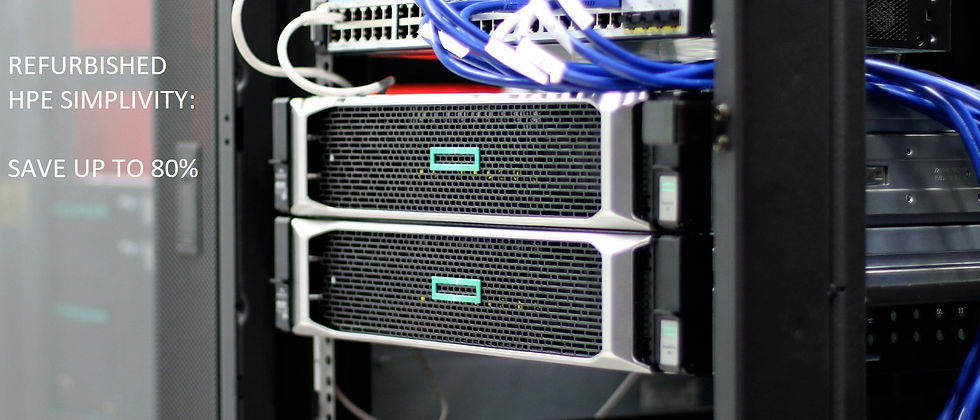HPE ProLiant DL380 Server Comparison: Gen10 vs. Gen11 - Do You Actually Need an Upgrade?
- Zo Jakab
- Aug 29, 2023
- 3 min read
Updated: Aug 12
HPE ProLiant servers are among the most widely deployed enterprise rack servers in their class. The DL380 model is a versatile 2U system used across many industries.
HPE ProLiant Servers: Save Up to 80%
✔️ No Upfront Payment Required - Test First, Pay Later!
This comparison focuses on the differences between the HPE ProLiant DL380 Gen10 and the HPE ProLiant DL380 Gen11 — both Intel-based models.
HPE ProLiant DL380 Gen10 vs Gen11: Specs Comparison
Specification | HPE ProLiant DL380 Gen10 | HPE ProLiant DL380 Gen11 |
Processor Support | Up to 2× Intel® Xeon® Scalable (1st or 2nd Gen), max 28 cores per CPU | Up to 2× Intel® Xeon® Scalable (4th or 5th Gen “Sapphire Rapids” / “Emerald Rapids”), max 64 cores per CPU |
Memory | 24 DIMM slots (max 3.0 TB DDR4 with LRDIMM, 1.5 TB with RDIMM, up to 2933 MT/s) | 32 DIMM slots (16 per CPU, max 8.0 TB DDR5, up to 5600 MT/s) |
Storage | Up to 30× SFF or 19× LFF drives (varies by chassis), NVMe supported | Up to 20× EDSFF drives plus up to 8× additional SFF drives, NVMe supported |
Expansion Slots | Up to 8× PCIe 3.0 slots | Up to 8× PCIe 5.0 slots |
Networking | FlexibleLOM adapters supporting 1/10/25 GbE | OCP 3.0 adapters supporting 10/25/100 GbE |
Power Supply | 500 W, 800 W, or 1600 W Platinum/Titanium hot-plug | 800 W, 1000 W, or 1600 W Platinum/Titanium hot-plug |
Management | HPE iLO 5 with optional HPE OneView integration | HPE iLO 6 with HPE GreenLake for Compute Ops Management |
Security | Silicon root of trust, TPM 2.0, Secure Boot | Enhanced silicon root of trust, TPM 2.0 (standard), SPDM support, platform certificates with iDevID |
GPU Support | Up to 4× single-wide or 3× double-wide GPUs | Up to 8× single-wide or 3× double-wide GPUs |
Form Factor | 2U rack server | 2U rack server |
Cooling | Standard or high-performance fan kits | Advanced cooling for higher-power CPUs/GPUs |
Operating Temp | 10 °C to 35 °C | 10 °C to 35 °C |
Warranty | 3-year parts, labor, and onsite | 3-year parts, labor, and onsite |
Note: Specifications may vary based on configuration and regional availability. For the most accurate and up-to-date information, please refer to HPE's official documentation or contact an authorized HPE representative.
HPE ProLiant DL380 Gen10: Key Features and Capabilities
Launch Year: 2017
CPU Platform: Intel Purley (Skylake-SP, Cascade Lake-SP)
Architecture & Design: Security-focused design with HPE’s silicon root of trust to protect firmware at boot.
Performance: Well-suited for virtualization, general compute, and storage-heavy workloads.
Management: HPE iLO 5 with optional OneView integration for on-premises infrastructure control.
Workloads: Best for traditional data center tasks, virtualization, and enterprise applications.
Ecosystem: Still widely supported, but limited to DDR4 memory and PCIe 3.0, which may restrict compatibility with some new components.
HPE ProLiant DL380 Gen11: Key Features and Capabilities
Launch Year: Late 2022
CPU Platform: Intel Sapphire Rapids / Emerald Rapids
Architecture & Design: Built for high core counts, faster memory, and higher I/O throughput.
Performance: Large improvements over Gen10 in per-core processing, memory bandwidth, and PCIe throughput.
Management: Ships with iLO 6 and HPE GreenLake for Compute Ops Management (SaaS-based, on-prem and hybrid support).
Security: Adds platform certificates, iDevID, and SPDM support for third-party component verification.
Workloads: Handles both traditional enterprise workloads and modern cloud-native or AI/ML deployments.
Ecosystem: Designed for DDR5, PCIe 5.0, and EDSFF storage, enabling adoption of the latest storage and accelerator technology.
Choosing Between HPE ProLiant DL380 Gen10 vs HPE ProLiant DL380 Gen11
When HPE ProLiant DL380 Gen10 is a good choice:
Existing infrastructure is Gen10-based, and you need to expand or replace servers without a platform change.
Budget constraints make refurbished Gen10 hardware attractive.
Workloads don’t require DDR5 memory, PCIe 5.0, or the highest core counts.
When HPE ProLiant DL380 Gen11 is a better fit:
You need maximum performance per rack unit.
You’re planning for AI/ML, large-scale virtualization, or high-performance storage systems.
You want modern management and security enhancements.
HPE ProLiant Servers: Save Up to 80%
✔️ No Upfront Payment Required - Test First, Pay Later!






Comments